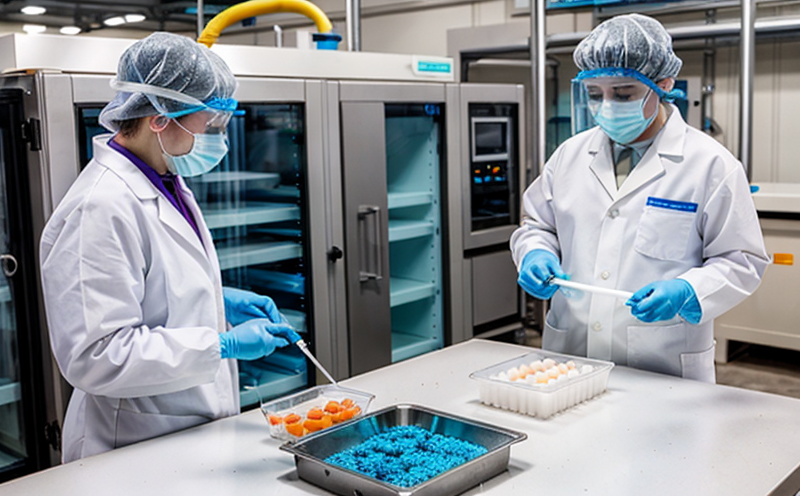ASTM E2315 Antimicrobial Efficacy Test for Toy Materials
The ASTM E2315 standard provides a comprehensive method to evaluate the antimicrobial efficacy of toy materials. This test is crucial in ensuring that toys do not pose health risks, especially to children who may have compromised immune systems or are more susceptible to infections due to their age and developmental stage.
ASTM E2315 specifies procedures for determining whether a material used in the manufacture of toys can effectively inhibit the growth of microorganisms. The test is designed to assess the antimicrobial properties of toy components, such as plastics, rubber, textiles, and coatings, under conditions that mimic real-world exposure scenarios.
The testing process involves exposing the toy materials to specific strains of bacteria or fungi, then measuring the reduction in microbial population after a defined contact period. This method ensures that toys are not only safe but also hygienic, thereby promoting consumer confidence and safety.
It is essential to note that ASTM E2315 is part of a broader framework of standards aimed at ensuring toy safety and quality. Compliance with this standard helps manufacturers meet regulatory requirements and enhances the overall safety profile of their products.
The test setup includes the following key components:
- Specimen preparation: Standardized cutting of the toy material to ensure uniformity in testing.
- Microbial inoculation: Exposure of the specimen to specified strains of bacteria or fungi.
- Contact time: Defined period during which the antimicrobial properties are tested.
- Testing media: Specific solutions that facilitate microbial growth and subsequent evaluation.
The ASTM E2315 standard is widely recognized for its robustness and accuracy, making it a preferred choice in the toy industry. Compliance with this test ensures that toys meet stringent safety standards and can be marketed confidently to consumers worldwide.
| Testing Parameters | Description |
|---|---|
| Microbial Strains | Bacterial strains such as S. aureus or fungal strains like Candida albicans |
| Contact Time | Typically 24 hours, but can vary based on specimen type and microbial strain |
| Testing Media | Standardized solutions that support microbial growth and activity |
| Specimen Preparation | Cutting to standard sizes for uniform testing conditions |
The ASTM E2315 test is not just a compliance requirement but also an essential tool in the development of safer and more hygienic toys. By adhering to this standard, toy manufacturers can ensure that their products meet the highest safety standards.
Applied Standards
The ASTM E2315 standard aligns with several other international standards aimed at ensuring toy safety and quality. These include:
- ISO 846:2019 - This standard provides a framework for the microbiological quality of medical devices, which can be applied analogously to toys.
- EN 71-3:2019 - Part of the European Standard that specifies requirements and test methods for mechanical & physical properties of toys.
- IEC 62196:2015 - This standard addresses electrical safety aspects, which are crucial in ensuring that electronic toys do not pose a risk to users.
- ASTM F963-17 - The general requirements for toy safety, including chemical and microbiological properties.
The integration of ASTM E2315 with these standards ensures that toy manufacturers have access to comprehensive guidelines that cover multiple aspects of product safety and quality. This holistic approach helps in creating toys that are not only safe but also meet the highest international standards.
International Acceptance and Recognition
The ASTM E2315 standard is internationally recognized for its rigorous testing methods and comprehensive evaluation of antimicrobial efficacy. Its acceptance spans across various regions, including North America, Europe, Asia, and Australia. Countries like the United States, Canada, Germany, Japan, and China have incorporated ASTM E2315 into their national toy safety regulations.
- United States: ASTM E2315 is widely recognized by the Consumer Product Safety Commission (CPSC) as a key standard for ensuring toy safety.
- Canada: The Canadian Standards Association (CSA) references ASTM E2315 in its guidelines for toy manufacturing and safety.
- Germany: The German Institute for Standardization (DIN) includes ASTM E2315 as part of its national standards for toy safety.
- Japan: JIS standards frequently reference ASTM E2315, reflecting the importance of this test in Japanese toy manufacturing.
- Australia: The Australian Competition and Consumer Commission (ACCC) recommends compliance with ASTM E2315 for ensuring toy safety.
The widespread acceptance of ASTM E2315 underscores its significance in the global toy industry. Manufacturers who comply with this standard can enjoy a competitive edge, ensuring that their products meet international standards and are safe for use worldwide.
Use Cases and Application Examples
The ASTM E2315 antimicrobial efficacy test is applicable in various scenarios within the toy manufacturing process. Here are some key use cases:
| Use Case | Description |
|---|---|
| New Material Introduction | Evaluating new materials for their antimicrobial properties before mass production. |
| Product Recall Analysis | Investigating the cause of microbial contamination during a product recall to ensure corrective measures are taken. |
| R&D Innovation | Testing experimental formulations to identify new antimicrobial compounds that can be used in toy manufacturing. |
| Supply Chain Management | Ensuring the quality of materials supplied by third-party vendors through routine ASTM E2315 testing. |
| Export Compliance | Making sure toys meet international standards for export to countries with stringent safety regulations. |
| Sustainability Initiatives | Identifying sustainable materials that not only are safe but also have inherent antimicrobial properties. |
| User Safety Enhancement | Evaluating the effectiveness of antimicrobial treatments in existing toy products to enhance user safety further. |
These use cases highlight the versatility and importance of ASTM E2315 in ensuring that toys are not only safe but also hygienic. By incorporating this test into their quality control processes, manufacturers can ensure a safer product for consumers worldwide.





